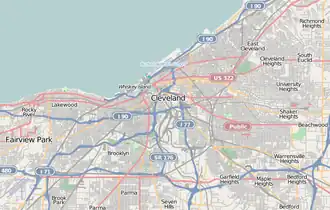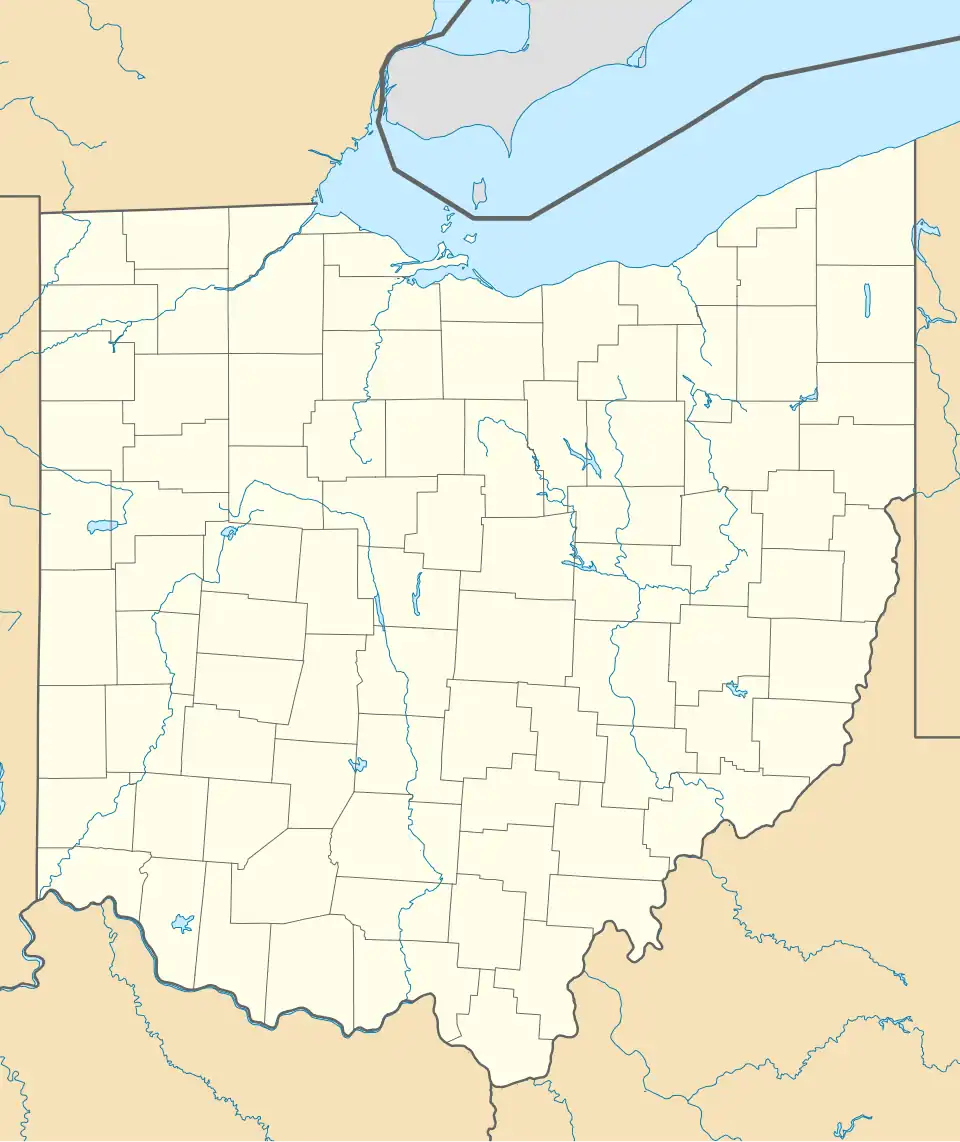St. John African Methodist Episcopal Church (Cleveland)
St. John's AME Church | |
 | |
   | |
| Location | 2261 E. 40th St., Cleveland, Ohio |
|---|---|
| Coordinates | 41°29′48″N 81°39′22″W / 41.49667°N 81.65611°W |
| Area | less than one acre |
| Built | 1908 |
| Architect | Badgley & Nicklas; Aring, John F. |
| Architectural style | Gothic, Gothic eclectic |
| MPS | Black History TR |
| NRHP reference No. | 82001370[1] |
| Added to NRHP | December 17, 1982 |
St. John's African Methodist Episcopal Church is a historic church at 2261 East 40th Street in Cleveland, Ohio.
Founded in 1836[2] by six fugitive slaves,[3] St. John's AME Church was first African American Christian congregation ever formed in Cleveland.[3] The congregation has a long history of civil rights activism.[2] Its original church building was known as "Station Hope" on the Underground Railroad.[4] Under the pastorate of Rev. Reverdy C. Ransom (1893 to 1896), it implemented an extensive program of social outreach, including education classes, kindergarten, sports, and health.[5] The congregation hosted Booker T. Washington in 1897[6] and W. E. B. Du Bois in 1908.[7]
The congregation began construction on a permanent church home in February 1908.[8][9] The English Gothic[8] style building was designed by the local architectural firm of Badgley & Nicklas.[2][8] Construction ws completed in mid December 1908.[9] At the time, it was the largest church ever constructed by a Black congregation in the city of Cleveland.[10]
It was added to the National Register in 1982. It is considered a historic Black church in Cleveland,[11] and is a city-designated Cleveland Historic Landmark.[12]
References
- ^ "National Register Information System". National Register of Historic Places. National Park Service. March 13, 2009.
- ^ a b c Rice, Karen Connelly (December 7, 2023). "St. John African Methodist Episcopal Church: A Pillar of Civil Rights and Community". FreshWater Cleveland. Retrieved July 14, 2025.
- ^ a b LaRoche, Cheryl Janifer (2025). Apostle of Liberation: AME Bishop Paul Quinn and the Underground Railroad. Lanham, Md.: Rowman & Littlefield. p. 51. ISBN 9781538198117.
- ^ Calarco, Tom; Vogel, Cynthia; Grover, Kathryn; Hallstrom, Rae; Pope, Sharron L.; Waddy-Thibodeaux, Melissa (2011). Places of the Underground Railroad: A Geographical Guide. Santa Barbara, Calif.: Greenwood Press. p. 79. ISBN 9780313381461.
- ^ Bryan, Mary Lynn; De Angury, De Maree, eds. (2017). Selected Papers of Jane Addams: Creating Hull-House and an International Presence, 1889-1900. Urbana, Ill.: University of Illinois Press. p. 728. ISBN 9780252040979; Smith, Gary Scott, ed. (2021). American Religious History: Belief and Society Through Time. Santa Barbara, Calif.: ABC=CLIO. p. 232. ISBN 9781440861604.
- ^ "In the South". The Cleveland Press. February 15, 1897. p. 2; "To Lift Up A race". The Cleveland Leader. February 15, 1897. p. 7.
- ^ "Riot Deplored By Negro". The Plain Dealer. August 31, 1908. p. 2.
- ^ a b c "New St. John's African Methodist Episcopal Church". The Plain Dealer. February 16, 1908. p. 8.
- ^ a b "Bishop Praises Pastor". The Plain Dealer. December 14, 1908. p. 5.
- ^ Harris, Danita (December 23, 2024). "The Future of Faith: Historic St. John AME Church in Cleveland embraces change to secure its mission". WKYC. Retrieved August 5, 2025.
- ^ Huesken, Mary Ellen Crowley; Perkins, Olivera (July 2, 2025). "Explore this map of some of Cleveland's historic Black churches". Signal Cleveland. Retrieved July 7, 2025.
- ^ Cleveland Planning Commission (2025). "Cleveland Designated Landmarks. Property Detail: St. John AME Church". planning.clevelandohio.gov. Retrieved August 3, 2025.

